Nottingham Trent University: Real Estate Funding and Finance Report
VerifiedAdded on 2022/10/19
|11
|2499
|16
Report
AI Summary
This report analyzes the impact of borrowing costs on real estate investment returns, focusing on the UK market using FTSE 350 data. It examines how factors like lending conditions, capital structure, and the cost of equity and debt influence real estate investments. The analysis includes the application of the Capital Asset Pricing Model (CAPM) to determine the cost of equity and considers factors like the loan-to-value ratio and working capital. The report also explores the impact of the 2008 financial crisis on capital availability and the role of debt financing in the real estate sector, highlighting the interplay of financial risk and capital structure decisions. Ultimately, the report provides a comprehensive overview of how financial factors shape real estate investment returns and risk.
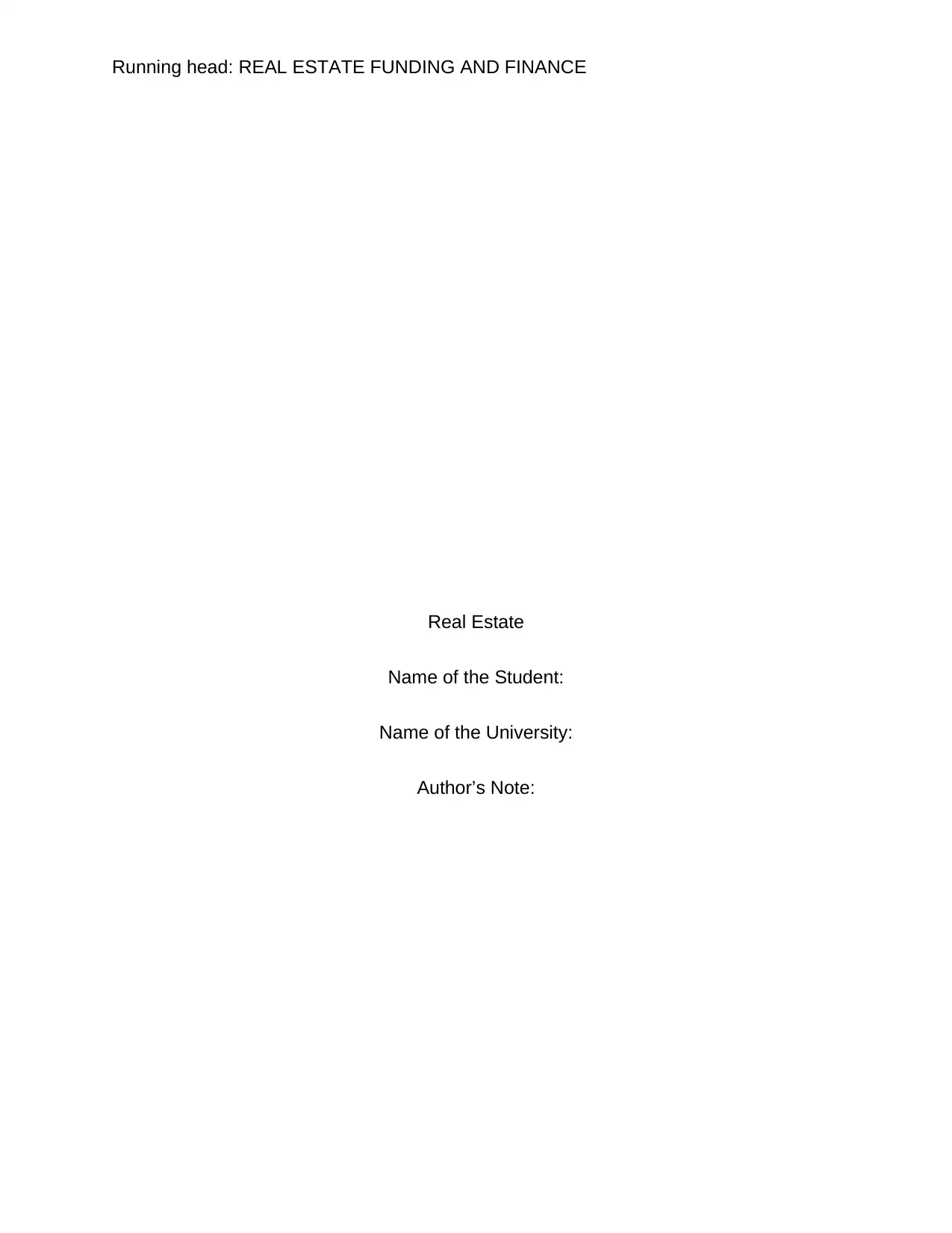
Running head: REAL ESTATE FUNDING AND FINANCE
Real Estate
Name of the Student:
Name of the University:
Author’s Note:
Real Estate
Name of the Student:
Name of the University:
Author’s Note:
Paraphrase This Document
Need a fresh take? Get an instant paraphrase of this document with our AI Paraphraser
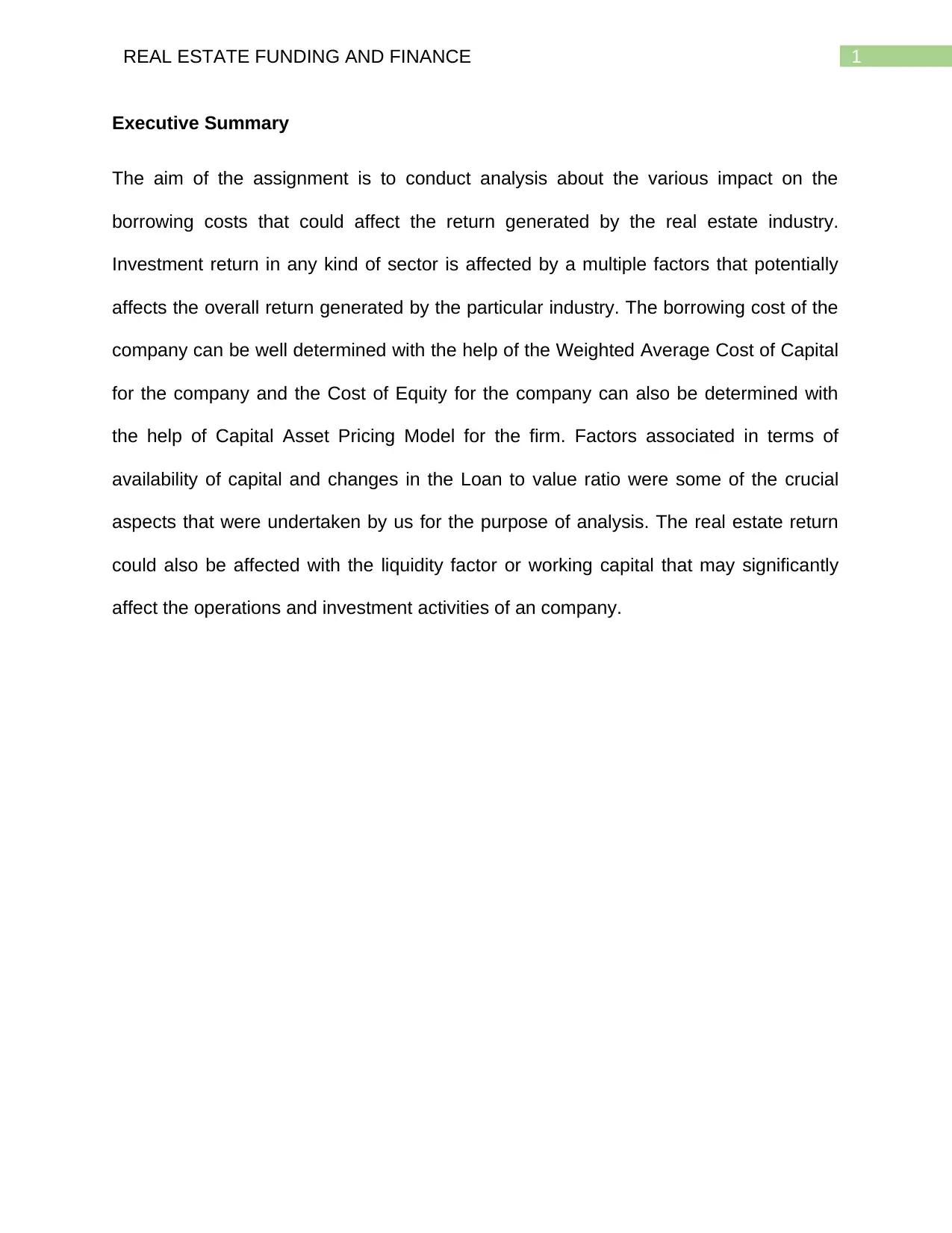
1REAL ESTATE FUNDING AND FINANCE
Executive Summary
The aim of the assignment is to conduct analysis about the various impact on the
borrowing costs that could affect the return generated by the real estate industry.
Investment return in any kind of sector is affected by a multiple factors that potentially
affects the overall return generated by the particular industry. The borrowing cost of the
company can be well determined with the help of the Weighted Average Cost of Capital
for the company and the Cost of Equity for the company can also be determined with
the help of Capital Asset Pricing Model for the firm. Factors associated in terms of
availability of capital and changes in the Loan to value ratio were some of the crucial
aspects that were undertaken by us for the purpose of analysis. The real estate return
could also be affected with the liquidity factor or working capital that may significantly
affect the operations and investment activities of an company.
Executive Summary
The aim of the assignment is to conduct analysis about the various impact on the
borrowing costs that could affect the return generated by the real estate industry.
Investment return in any kind of sector is affected by a multiple factors that potentially
affects the overall return generated by the particular industry. The borrowing cost of the
company can be well determined with the help of the Weighted Average Cost of Capital
for the company and the Cost of Equity for the company can also be determined with
the help of Capital Asset Pricing Model for the firm. Factors associated in terms of
availability of capital and changes in the Loan to value ratio were some of the crucial
aspects that were undertaken by us for the purpose of analysis. The real estate return
could also be affected with the liquidity factor or working capital that may significantly
affect the operations and investment activities of an company.
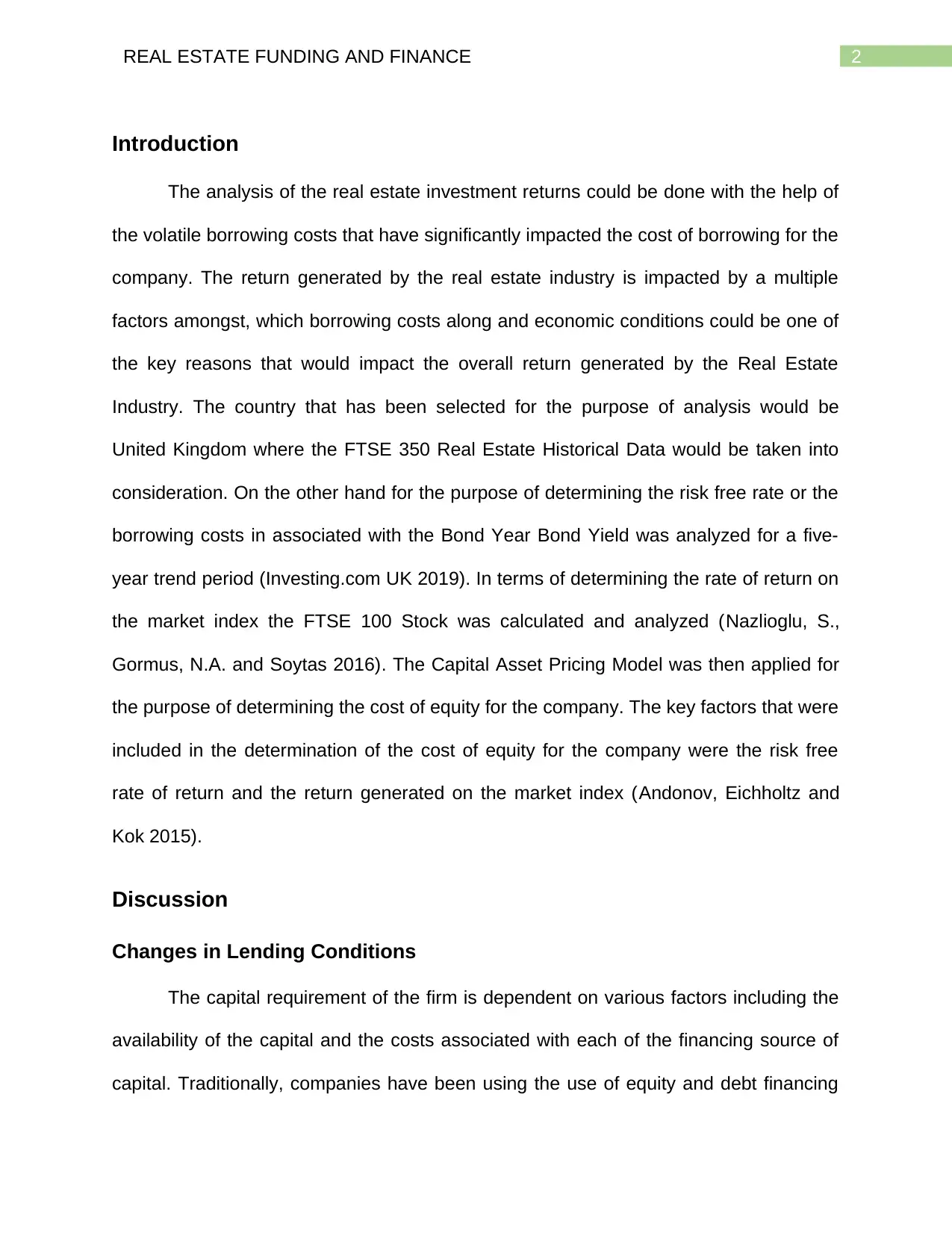
2REAL ESTATE FUNDING AND FINANCE
Introduction
The analysis of the real estate investment returns could be done with the help of
the volatile borrowing costs that have significantly impacted the cost of borrowing for the
company. The return generated by the real estate industry is impacted by a multiple
factors amongst, which borrowing costs along and economic conditions could be one of
the key reasons that would impact the overall return generated by the Real Estate
Industry. The country that has been selected for the purpose of analysis would be
United Kingdom where the FTSE 350 Real Estate Historical Data would be taken into
consideration. On the other hand for the purpose of determining the risk free rate or the
borrowing costs in associated with the Bond Year Bond Yield was analyzed for a five-
year trend period (Investing.com UK 2019). In terms of determining the rate of return on
the market index the FTSE 100 Stock was calculated and analyzed (Nazlioglu, S.,
Gormus, N.A. and Soytas 2016). The Capital Asset Pricing Model was then applied for
the purpose of determining the cost of equity for the company. The key factors that were
included in the determination of the cost of equity for the company were the risk free
rate of return and the return generated on the market index (Andonov, Eichholtz and
Kok 2015).
Discussion
Changes in Lending Conditions
The capital requirement of the firm is dependent on various factors including the
availability of the capital and the costs associated with each of the financing source of
capital. Traditionally, companies have been using the use of equity and debt financing
Introduction
The analysis of the real estate investment returns could be done with the help of
the volatile borrowing costs that have significantly impacted the cost of borrowing for the
company. The return generated by the real estate industry is impacted by a multiple
factors amongst, which borrowing costs along and economic conditions could be one of
the key reasons that would impact the overall return generated by the Real Estate
Industry. The country that has been selected for the purpose of analysis would be
United Kingdom where the FTSE 350 Real Estate Historical Data would be taken into
consideration. On the other hand for the purpose of determining the risk free rate or the
borrowing costs in associated with the Bond Year Bond Yield was analyzed for a five-
year trend period (Investing.com UK 2019). In terms of determining the rate of return on
the market index the FTSE 100 Stock was calculated and analyzed (Nazlioglu, S.,
Gormus, N.A. and Soytas 2016). The Capital Asset Pricing Model was then applied for
the purpose of determining the cost of equity for the company. The key factors that were
included in the determination of the cost of equity for the company were the risk free
rate of return and the return generated on the market index (Andonov, Eichholtz and
Kok 2015).
Discussion
Changes in Lending Conditions
The capital requirement of the firm is dependent on various factors including the
availability of the capital and the costs associated with each of the financing source of
capital. Traditionally, companies have been using the use of equity and debt financing
⊘ This is a preview!⊘
Do you want full access?
Subscribe today to unlock all pages.

Trusted by 1+ million students worldwide
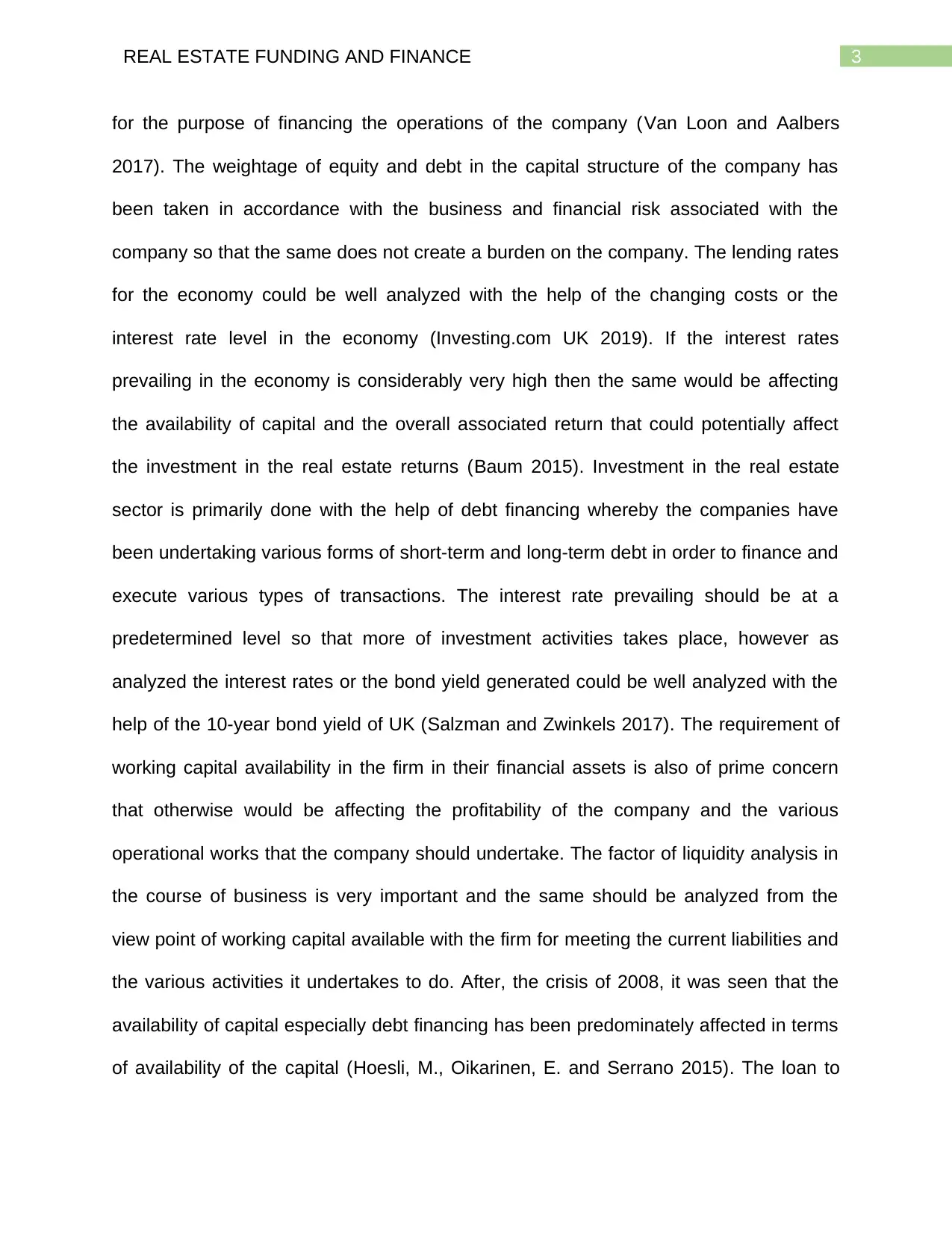
3REAL ESTATE FUNDING AND FINANCE
for the purpose of financing the operations of the company (Van Loon and Aalbers
2017). The weightage of equity and debt in the capital structure of the company has
been taken in accordance with the business and financial risk associated with the
company so that the same does not create a burden on the company. The lending rates
for the economy could be well analyzed with the help of the changing costs or the
interest rate level in the economy (Investing.com UK 2019). If the interest rates
prevailing in the economy is considerably very high then the same would be affecting
the availability of capital and the overall associated return that could potentially affect
the investment in the real estate returns (Baum 2015). Investment in the real estate
sector is primarily done with the help of debt financing whereby the companies have
been undertaking various forms of short-term and long-term debt in order to finance and
execute various types of transactions. The interest rate prevailing should be at a
predetermined level so that more of investment activities takes place, however as
analyzed the interest rates or the bond yield generated could be well analyzed with the
help of the 10-year bond yield of UK (Salzman and Zwinkels 2017). The requirement of
working capital availability in the firm in their financial assets is also of prime concern
that otherwise would be affecting the profitability of the company and the various
operational works that the company should undertake. The factor of liquidity analysis in
the course of business is very important and the same should be analyzed from the
view point of working capital available with the firm for meeting the current liabilities and
the various activities it undertakes to do. After, the crisis of 2008, it was seen that the
availability of capital especially debt financing has been predominately affected in terms
of availability of the capital (Hoesli, M., Oikarinen, E. and Serrano 2015). The loan to
for the purpose of financing the operations of the company (Van Loon and Aalbers
2017). The weightage of equity and debt in the capital structure of the company has
been taken in accordance with the business and financial risk associated with the
company so that the same does not create a burden on the company. The lending rates
for the economy could be well analyzed with the help of the changing costs or the
interest rate level in the economy (Investing.com UK 2019). If the interest rates
prevailing in the economy is considerably very high then the same would be affecting
the availability of capital and the overall associated return that could potentially affect
the investment in the real estate returns (Baum 2015). Investment in the real estate
sector is primarily done with the help of debt financing whereby the companies have
been undertaking various forms of short-term and long-term debt in order to finance and
execute various types of transactions. The interest rate prevailing should be at a
predetermined level so that more of investment activities takes place, however as
analyzed the interest rates or the bond yield generated could be well analyzed with the
help of the 10-year bond yield of UK (Salzman and Zwinkels 2017). The requirement of
working capital availability in the firm in their financial assets is also of prime concern
that otherwise would be affecting the profitability of the company and the various
operational works that the company should undertake. The factor of liquidity analysis in
the course of business is very important and the same should be analyzed from the
view point of working capital available with the firm for meeting the current liabilities and
the various activities it undertakes to do. After, the crisis of 2008, it was seen that the
availability of capital especially debt financing has been predominately affected in terms
of availability of the capital (Hoesli, M., Oikarinen, E. and Serrano 2015). The loan to
Paraphrase This Document
Need a fresh take? Get an instant paraphrase of this document with our AI Paraphraser
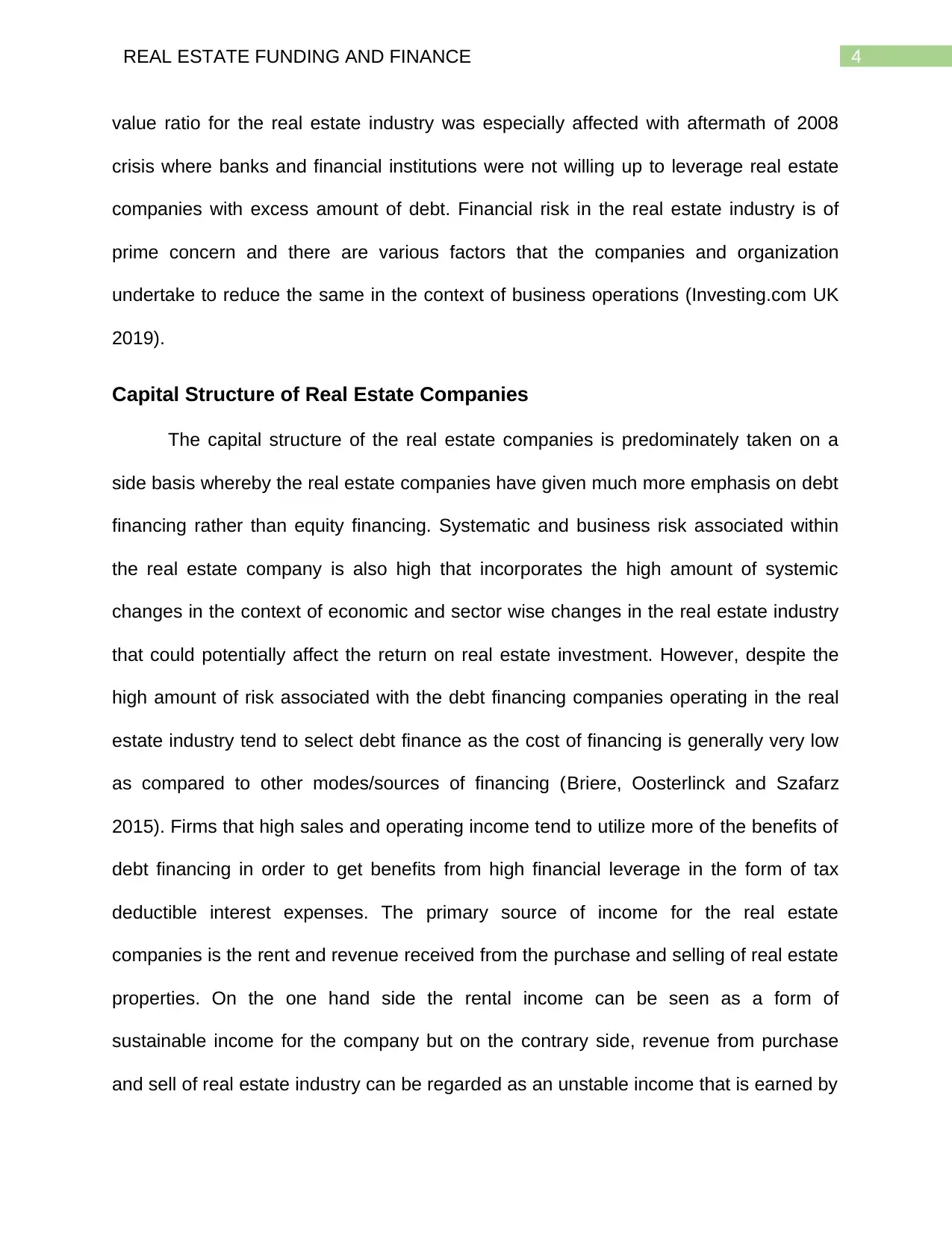
4REAL ESTATE FUNDING AND FINANCE
value ratio for the real estate industry was especially affected with aftermath of 2008
crisis where banks and financial institutions were not willing up to leverage real estate
companies with excess amount of debt. Financial risk in the real estate industry is of
prime concern and there are various factors that the companies and organization
undertake to reduce the same in the context of business operations (Investing.com UK
2019).
Capital Structure of Real Estate Companies
The capital structure of the real estate companies is predominately taken on a
side basis whereby the real estate companies have given much more emphasis on debt
financing rather than equity financing. Systematic and business risk associated within
the real estate company is also high that incorporates the high amount of systemic
changes in the context of economic and sector wise changes in the real estate industry
that could potentially affect the return on real estate investment. However, despite the
high amount of risk associated with the debt financing companies operating in the real
estate industry tend to select debt finance as the cost of financing is generally very low
as compared to other modes/sources of financing (Briere, Oosterlinck and Szafarz
2015). Firms that high sales and operating income tend to utilize more of the benefits of
debt financing in order to get benefits from high financial leverage in the form of tax
deductible interest expenses. The primary source of income for the real estate
companies is the rent and revenue received from the purchase and selling of real estate
properties. On the one hand side the rental income can be seen as a form of
sustainable income for the company but on the contrary side, revenue from purchase
and sell of real estate industry can be regarded as an unstable income that is earned by
value ratio for the real estate industry was especially affected with aftermath of 2008
crisis where banks and financial institutions were not willing up to leverage real estate
companies with excess amount of debt. Financial risk in the real estate industry is of
prime concern and there are various factors that the companies and organization
undertake to reduce the same in the context of business operations (Investing.com UK
2019).
Capital Structure of Real Estate Companies
The capital structure of the real estate companies is predominately taken on a
side basis whereby the real estate companies have given much more emphasis on debt
financing rather than equity financing. Systematic and business risk associated within
the real estate company is also high that incorporates the high amount of systemic
changes in the context of economic and sector wise changes in the real estate industry
that could potentially affect the return on real estate investment. However, despite the
high amount of risk associated with the debt financing companies operating in the real
estate industry tend to select debt finance as the cost of financing is generally very low
as compared to other modes/sources of financing (Briere, Oosterlinck and Szafarz
2015). Firms that high sales and operating income tend to utilize more of the benefits of
debt financing in order to get benefits from high financial leverage in the form of tax
deductible interest expenses. The primary source of income for the real estate
companies is the rent and revenue received from the purchase and selling of real estate
properties. On the one hand side the rental income can be seen as a form of
sustainable income for the company but on the contrary side, revenue from purchase
and sell of real estate industry can be regarded as an unstable income that is earned by
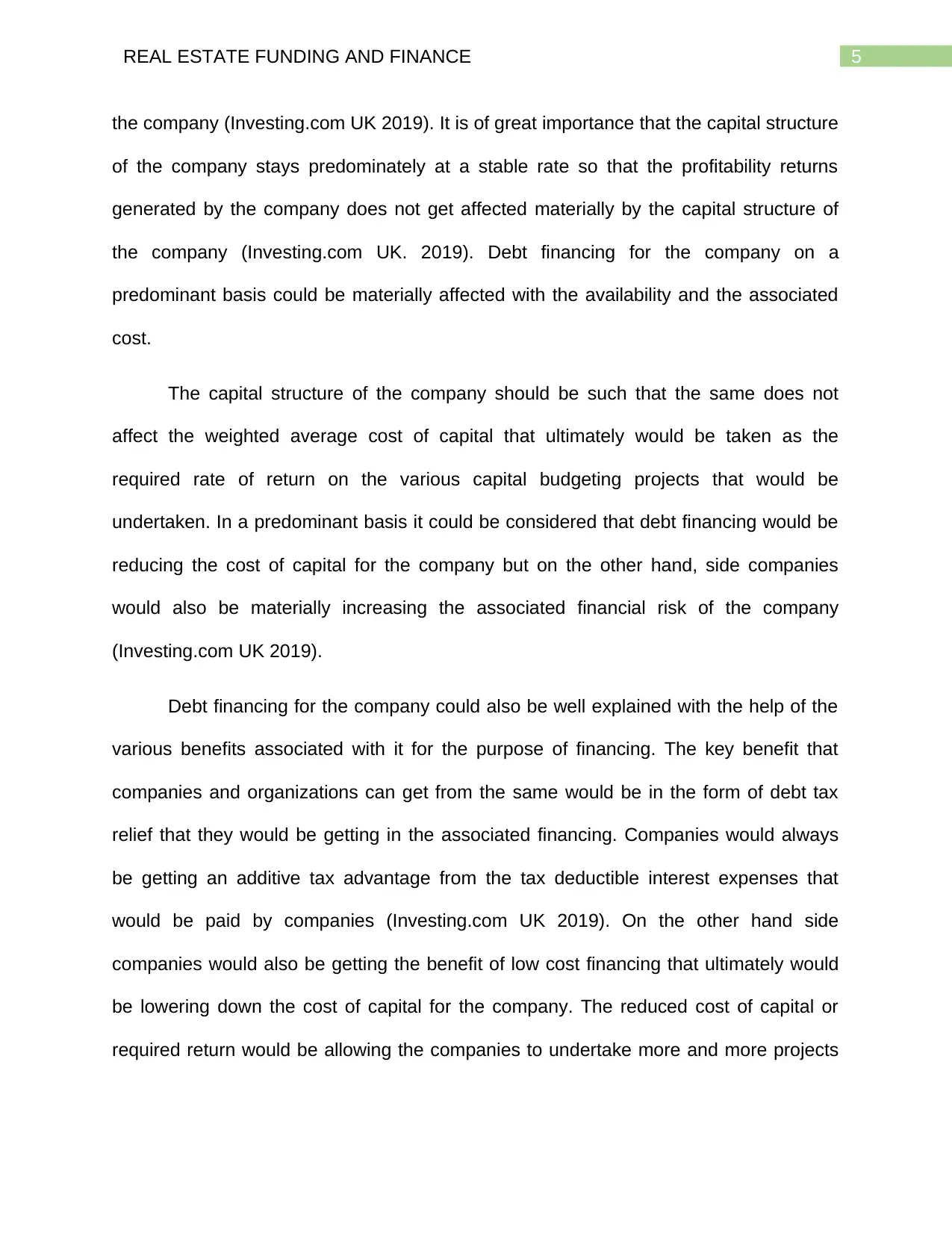
5REAL ESTATE FUNDING AND FINANCE
the company (Investing.com UK 2019). It is of great importance that the capital structure
of the company stays predominately at a stable rate so that the profitability returns
generated by the company does not get affected materially by the capital structure of
the company (Investing.com UK. 2019). Debt financing for the company on a
predominant basis could be materially affected with the availability and the associated
cost.
The capital structure of the company should be such that the same does not
affect the weighted average cost of capital that ultimately would be taken as the
required rate of return on the various capital budgeting projects that would be
undertaken. In a predominant basis it could be considered that debt financing would be
reducing the cost of capital for the company but on the other hand, side companies
would also be materially increasing the associated financial risk of the company
(Investing.com UK 2019).
Debt financing for the company could also be well explained with the help of the
various benefits associated with it for the purpose of financing. The key benefit that
companies and organizations can get from the same would be in the form of debt tax
relief that they would be getting in the associated financing. Companies would always
be getting an additive tax advantage from the tax deductible interest expenses that
would be paid by companies (Investing.com UK 2019). On the other hand side
companies would also be getting the benefit of low cost financing that ultimately would
be lowering down the cost of capital for the company. The reduced cost of capital or
required return would be allowing the companies to undertake more and more projects
the company (Investing.com UK 2019). It is of great importance that the capital structure
of the company stays predominately at a stable rate so that the profitability returns
generated by the company does not get affected materially by the capital structure of
the company (Investing.com UK. 2019). Debt financing for the company on a
predominant basis could be materially affected with the availability and the associated
cost.
The capital structure of the company should be such that the same does not
affect the weighted average cost of capital that ultimately would be taken as the
required rate of return on the various capital budgeting projects that would be
undertaken. In a predominant basis it could be considered that debt financing would be
reducing the cost of capital for the company but on the other hand, side companies
would also be materially increasing the associated financial risk of the company
(Investing.com UK 2019).
Debt financing for the company could also be well explained with the help of the
various benefits associated with it for the purpose of financing. The key benefit that
companies and organizations can get from the same would be in the form of debt tax
relief that they would be getting in the associated financing. Companies would always
be getting an additive tax advantage from the tax deductible interest expenses that
would be paid by companies (Investing.com UK 2019). On the other hand side
companies would also be getting the benefit of low cost financing that ultimately would
be lowering down the cost of capital for the company. The reduced cost of capital or
required return would be allowing the companies to undertake more and more projects
⊘ This is a preview!⊘
Do you want full access?
Subscribe today to unlock all pages.

Trusted by 1+ million students worldwide
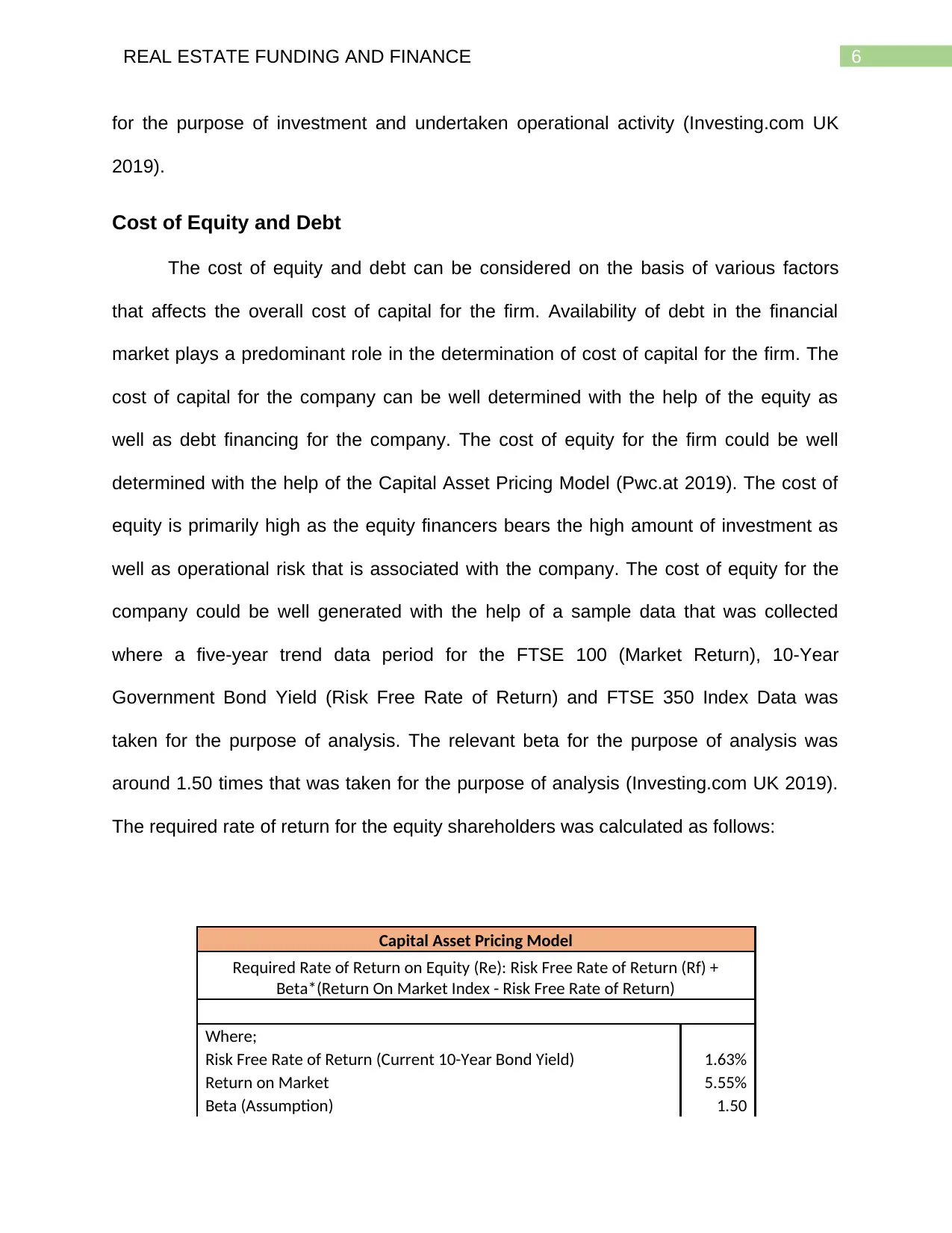
6REAL ESTATE FUNDING AND FINANCE
for the purpose of investment and undertaken operational activity (Investing.com UK
2019).
Cost of Equity and Debt
The cost of equity and debt can be considered on the basis of various factors
that affects the overall cost of capital for the firm. Availability of debt in the financial
market plays a predominant role in the determination of cost of capital for the firm. The
cost of capital for the company can be well determined with the help of the equity as
well as debt financing for the company. The cost of equity for the firm could be well
determined with the help of the Capital Asset Pricing Model (Pwc.at 2019). The cost of
equity is primarily high as the equity financers bears the high amount of investment as
well as operational risk that is associated with the company. The cost of equity for the
company could be well generated with the help of a sample data that was collected
where a five-year trend data period for the FTSE 100 (Market Return), 10-Year
Government Bond Yield (Risk Free Rate of Return) and FTSE 350 Index Data was
taken for the purpose of analysis. The relevant beta for the purpose of analysis was
around 1.50 times that was taken for the purpose of analysis (Investing.com UK 2019).
The required rate of return for the equity shareholders was calculated as follows:
Capital Asset Pricing Model
Required Rate of Return on Equity (Re): Risk Free Rate of Return (Rf) +
Beta*(Return On Market Index - Risk Free Rate of Return)
Where;
Risk Free Rate of Return (Current 10-Year Bond Yield) 1.63%
Return on Market 5.55%
Beta (Assumption) 1.50
for the purpose of investment and undertaken operational activity (Investing.com UK
2019).
Cost of Equity and Debt
The cost of equity and debt can be considered on the basis of various factors
that affects the overall cost of capital for the firm. Availability of debt in the financial
market plays a predominant role in the determination of cost of capital for the firm. The
cost of capital for the company can be well determined with the help of the equity as
well as debt financing for the company. The cost of equity for the firm could be well
determined with the help of the Capital Asset Pricing Model (Pwc.at 2019). The cost of
equity is primarily high as the equity financers bears the high amount of investment as
well as operational risk that is associated with the company. The cost of equity for the
company could be well generated with the help of a sample data that was collected
where a five-year trend data period for the FTSE 100 (Market Return), 10-Year
Government Bond Yield (Risk Free Rate of Return) and FTSE 350 Index Data was
taken for the purpose of analysis. The relevant beta for the purpose of analysis was
around 1.50 times that was taken for the purpose of analysis (Investing.com UK 2019).
The required rate of return for the equity shareholders was calculated as follows:
Capital Asset Pricing Model
Required Rate of Return on Equity (Re): Risk Free Rate of Return (Rf) +
Beta*(Return On Market Index - Risk Free Rate of Return)
Where;
Risk Free Rate of Return (Current 10-Year Bond Yield) 1.63%
Return on Market 5.55%
Beta (Assumption) 1.50
Paraphrase This Document
Need a fresh take? Get an instant paraphrase of this document with our AI Paraphraser
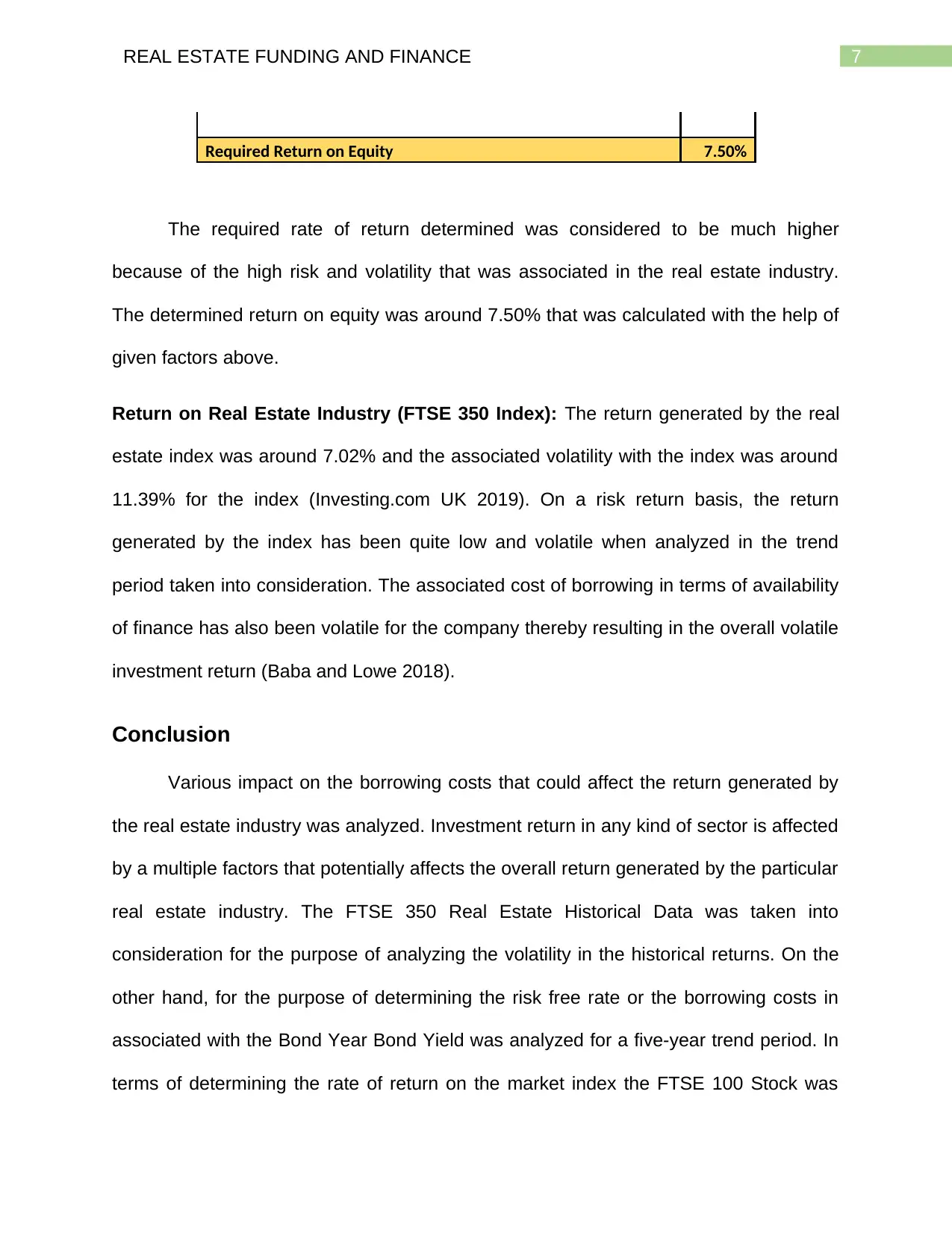
7REAL ESTATE FUNDING AND FINANCE
Required Return on Equity 7.50%
The required rate of return determined was considered to be much higher
because of the high risk and volatility that was associated in the real estate industry.
The determined return on equity was around 7.50% that was calculated with the help of
given factors above.
Return on Real Estate Industry (FTSE 350 Index): The return generated by the real
estate index was around 7.02% and the associated volatility with the index was around
11.39% for the index (Investing.com UK 2019). On a risk return basis, the return
generated by the index has been quite low and volatile when analyzed in the trend
period taken into consideration. The associated cost of borrowing in terms of availability
of finance has also been volatile for the company thereby resulting in the overall volatile
investment return (Baba and Lowe 2018).
Conclusion
Various impact on the borrowing costs that could affect the return generated by
the real estate industry was analyzed. Investment return in any kind of sector is affected
by a multiple factors that potentially affects the overall return generated by the particular
real estate industry. The FTSE 350 Real Estate Historical Data was taken into
consideration for the purpose of analyzing the volatility in the historical returns. On the
other hand, for the purpose of determining the risk free rate or the borrowing costs in
associated with the Bond Year Bond Yield was analyzed for a five-year trend period. In
terms of determining the rate of return on the market index the FTSE 100 Stock was
Required Return on Equity 7.50%
The required rate of return determined was considered to be much higher
because of the high risk and volatility that was associated in the real estate industry.
The determined return on equity was around 7.50% that was calculated with the help of
given factors above.
Return on Real Estate Industry (FTSE 350 Index): The return generated by the real
estate index was around 7.02% and the associated volatility with the index was around
11.39% for the index (Investing.com UK 2019). On a risk return basis, the return
generated by the index has been quite low and volatile when analyzed in the trend
period taken into consideration. The associated cost of borrowing in terms of availability
of finance has also been volatile for the company thereby resulting in the overall volatile
investment return (Baba and Lowe 2018).
Conclusion
Various impact on the borrowing costs that could affect the return generated by
the real estate industry was analyzed. Investment return in any kind of sector is affected
by a multiple factors that potentially affects the overall return generated by the particular
real estate industry. The FTSE 350 Real Estate Historical Data was taken into
consideration for the purpose of analyzing the volatility in the historical returns. On the
other hand, for the purpose of determining the risk free rate or the borrowing costs in
associated with the Bond Year Bond Yield was analyzed for a five-year trend period. In
terms of determining the rate of return on the market index the FTSE 100 Stock was

8REAL ESTATE FUNDING AND FINANCE
calculated and analyzed. The Capital Asset Pricing Model was then applied for the
purpose of determining the cost of equity for the company. Overall, it was found that the
investment returns in the real estate industry could be well analyzed and explained with
the help of changing capital structure and cost of financing for real estate companies.
calculated and analyzed. The Capital Asset Pricing Model was then applied for the
purpose of determining the cost of equity for the company. Overall, it was found that the
investment returns in the real estate industry could be well analyzed and explained with
the help of changing capital structure and cost of financing for real estate companies.
⊘ This is a preview!⊘
Do you want full access?
Subscribe today to unlock all pages.

Trusted by 1+ million students worldwide
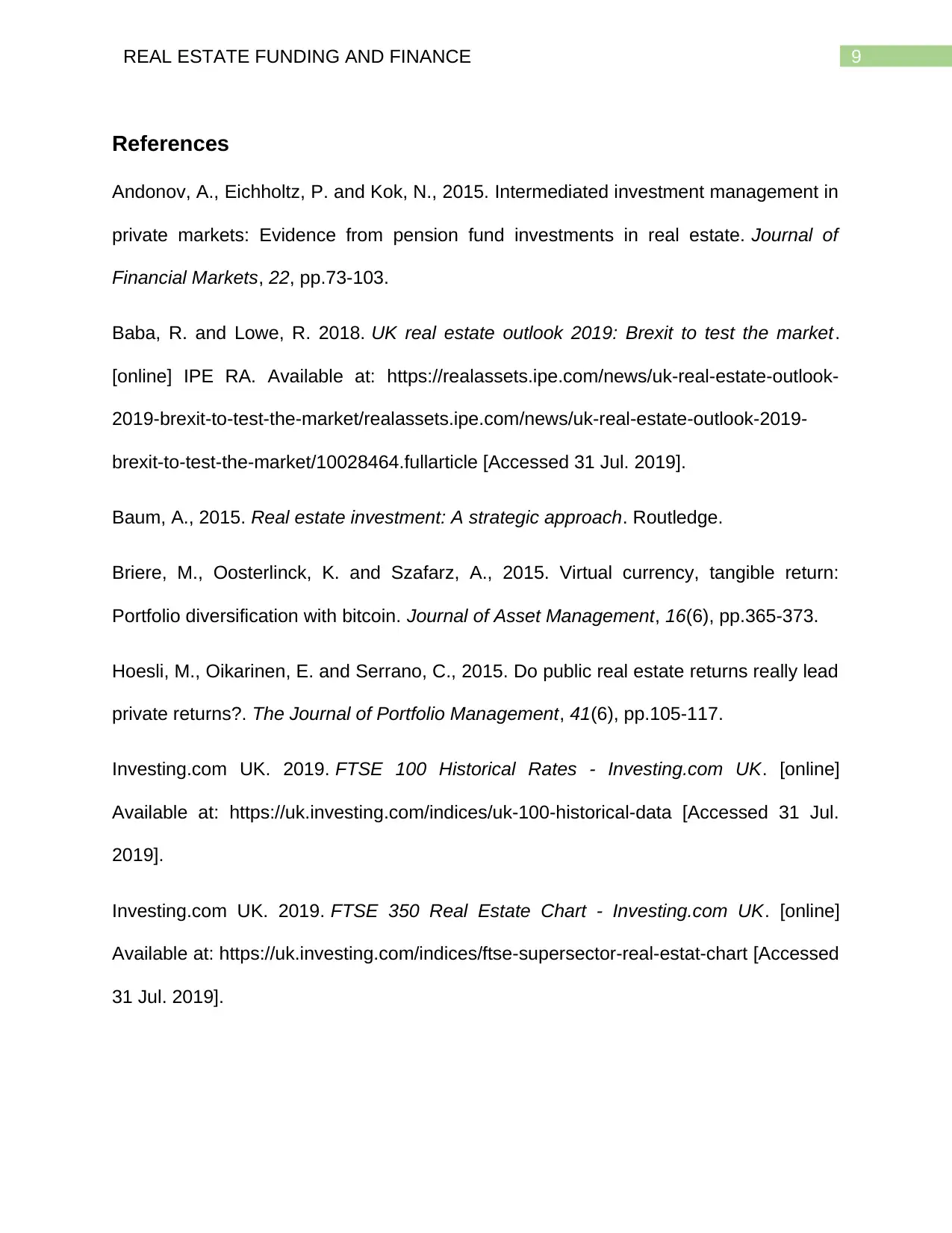
9REAL ESTATE FUNDING AND FINANCE
References
Andonov, A., Eichholtz, P. and Kok, N., 2015. Intermediated investment management in
private markets: Evidence from pension fund investments in real estate. Journal of
Financial Markets, 22, pp.73-103.
Baba, R. and Lowe, R. 2018. UK real estate outlook 2019: Brexit to test the market.
[online] IPE RA. Available at: https://realassets.ipe.com/news/uk-real-estate-outlook-
2019-brexit-to-test-the-market/realassets.ipe.com/news/uk-real-estate-outlook-2019-
brexit-to-test-the-market/10028464.fullarticle [Accessed 31 Jul. 2019].
Baum, A., 2015. Real estate investment: A strategic approach. Routledge.
Briere, M., Oosterlinck, K. and Szafarz, A., 2015. Virtual currency, tangible return:
Portfolio diversification with bitcoin. Journal of Asset Management, 16(6), pp.365-373.
Hoesli, M., Oikarinen, E. and Serrano, C., 2015. Do public real estate returns really lead
private returns?. The Journal of Portfolio Management, 41(6), pp.105-117.
Investing.com UK. 2019. FTSE 100 Historical Rates - Investing.com UK. [online]
Available at: https://uk.investing.com/indices/uk-100-historical-data [Accessed 31 Jul.
2019].
Investing.com UK. 2019. FTSE 350 Real Estate Chart - Investing.com UK. [online]
Available at: https://uk.investing.com/indices/ftse-supersector-real-estat-chart [Accessed
31 Jul. 2019].
References
Andonov, A., Eichholtz, P. and Kok, N., 2015. Intermediated investment management in
private markets: Evidence from pension fund investments in real estate. Journal of
Financial Markets, 22, pp.73-103.
Baba, R. and Lowe, R. 2018. UK real estate outlook 2019: Brexit to test the market.
[online] IPE RA. Available at: https://realassets.ipe.com/news/uk-real-estate-outlook-
2019-brexit-to-test-the-market/realassets.ipe.com/news/uk-real-estate-outlook-2019-
brexit-to-test-the-market/10028464.fullarticle [Accessed 31 Jul. 2019].
Baum, A., 2015. Real estate investment: A strategic approach. Routledge.
Briere, M., Oosterlinck, K. and Szafarz, A., 2015. Virtual currency, tangible return:
Portfolio diversification with bitcoin. Journal of Asset Management, 16(6), pp.365-373.
Hoesli, M., Oikarinen, E. and Serrano, C., 2015. Do public real estate returns really lead
private returns?. The Journal of Portfolio Management, 41(6), pp.105-117.
Investing.com UK. 2019. FTSE 100 Historical Rates - Investing.com UK. [online]
Available at: https://uk.investing.com/indices/uk-100-historical-data [Accessed 31 Jul.
2019].
Investing.com UK. 2019. FTSE 350 Real Estate Chart - Investing.com UK. [online]
Available at: https://uk.investing.com/indices/ftse-supersector-real-estat-chart [Accessed
31 Jul. 2019].
Paraphrase This Document
Need a fresh take? Get an instant paraphrase of this document with our AI Paraphraser
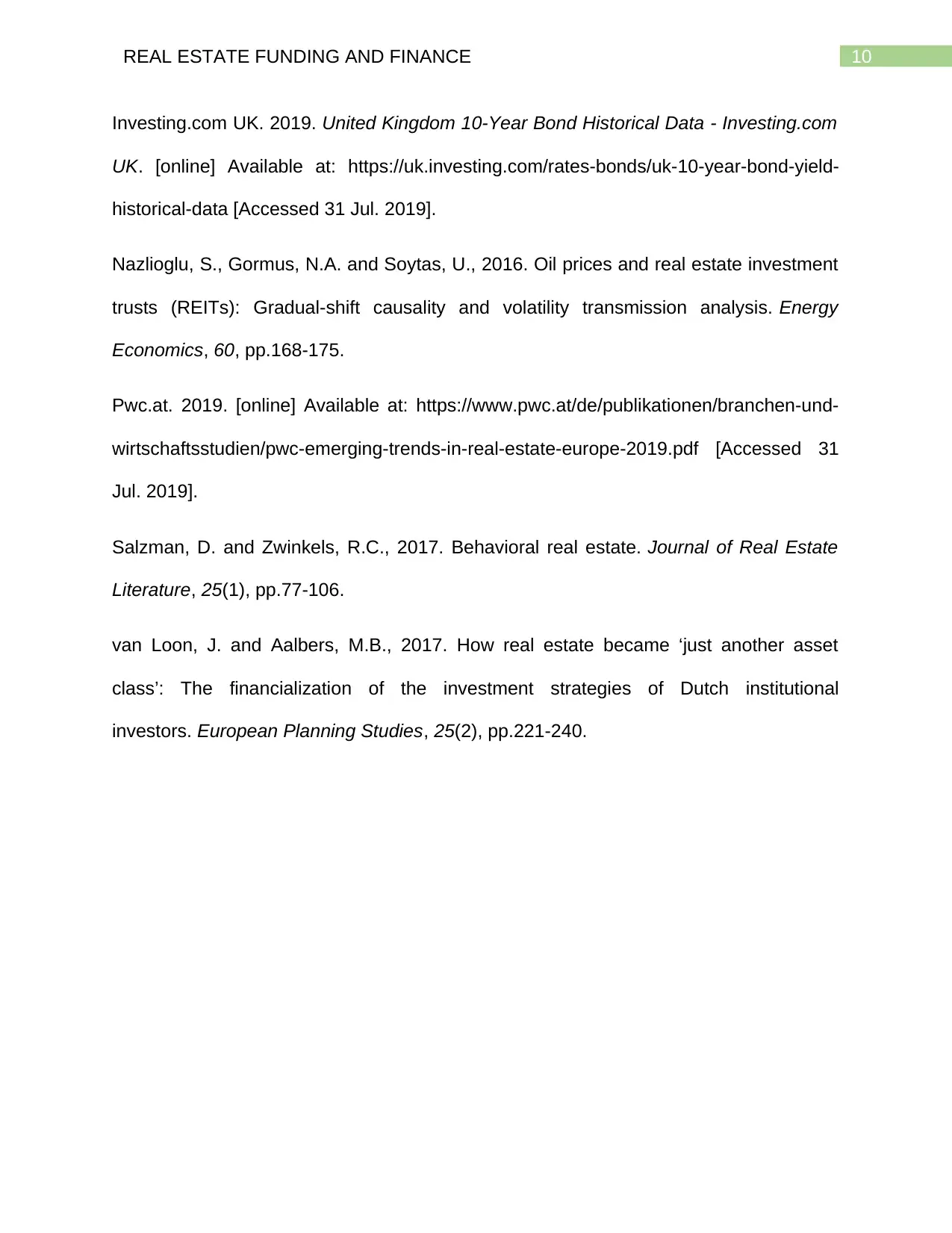
10REAL ESTATE FUNDING AND FINANCE
Investing.com UK. 2019. United Kingdom 10-Year Bond Historical Data - Investing.com
UK. [online] Available at: https://uk.investing.com/rates-bonds/uk-10-year-bond-yield-
historical-data [Accessed 31 Jul. 2019].
Nazlioglu, S., Gormus, N.A. and Soytas, U., 2016. Oil prices and real estate investment
trusts (REITs): Gradual-shift causality and volatility transmission analysis. Energy
Economics, 60, pp.168-175.
Pwc.at. 2019. [online] Available at: https://www.pwc.at/de/publikationen/branchen-und-
wirtschaftsstudien/pwc-emerging-trends-in-real-estate-europe-2019.pdf [Accessed 31
Jul. 2019].
Salzman, D. and Zwinkels, R.C., 2017. Behavioral real estate. Journal of Real Estate
Literature, 25(1), pp.77-106.
van Loon, J. and Aalbers, M.B., 2017. How real estate became ‘just another asset
class’: The financialization of the investment strategies of Dutch institutional
investors. European Planning Studies, 25(2), pp.221-240.
Investing.com UK. 2019. United Kingdom 10-Year Bond Historical Data - Investing.com
UK. [online] Available at: https://uk.investing.com/rates-bonds/uk-10-year-bond-yield-
historical-data [Accessed 31 Jul. 2019].
Nazlioglu, S., Gormus, N.A. and Soytas, U., 2016. Oil prices and real estate investment
trusts (REITs): Gradual-shift causality and volatility transmission analysis. Energy
Economics, 60, pp.168-175.
Pwc.at. 2019. [online] Available at: https://www.pwc.at/de/publikationen/branchen-und-
wirtschaftsstudien/pwc-emerging-trends-in-real-estate-europe-2019.pdf [Accessed 31
Jul. 2019].
Salzman, D. and Zwinkels, R.C., 2017. Behavioral real estate. Journal of Real Estate
Literature, 25(1), pp.77-106.
van Loon, J. and Aalbers, M.B., 2017. How real estate became ‘just another asset
class’: The financialization of the investment strategies of Dutch institutional
investors. European Planning Studies, 25(2), pp.221-240.
1 out of 11
Related Documents
Your All-in-One AI-Powered Toolkit for Academic Success.
+13062052269
info@desklib.com
Available 24*7 on WhatsApp / Email
![[object Object]](/_next/static/media/star-bottom.7253800d.svg)
Unlock your academic potential
Copyright © 2020–2025 A2Z Services. All Rights Reserved. Developed and managed by ZUCOL.





